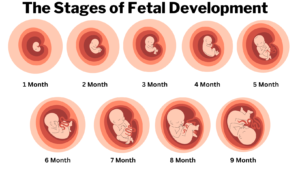 I. Introduction
I. Introduction
In the introduction, you can begin by explaining the significance of fetal development week by week. Highlight how this journey showcases the incredible growth and transformation of a fetus from conception to birth. Emphasize the curiosity and amazement that arises when exploring the intricate processes and milestones achieved during each week.
 II. First Trimester: Building Blocks of Life
II. First Trimester: Building Blocks of Life
A. Weeks 1-4
-During the first four weeks of pregnancy, the fetus is in its early stages of development. At Week 1, after the fertilization of the egg by sperm, a tiny cluster of cells called a zygote is formed. It starts to divide rapidly as it travels through the fallopian tube towards the uterus.
Week 2, the zygote reaches the uterus and implants itself into the uterine lining. It receives nourishment from the mother’s body to support its growth.
Week 3, the zygote continues to divide and grow, transforming into an embryo. The embryo starts developing a protective sac called the amniotic sac, which will eventually surround and protect the growing baby.
Week 4, the embryo is still very small, about the size of a poppy seed. Basic structures begin to form, such as the early stages of the brain, spinal cord, and heart. Blood vessels also start to develop, and the placenta begins to form, connecting the embryo to the mother’s bloodstream and providing essential nutrients and oxygen.
Although the fetus is still in its early stages and not yet recognizable as a baby, these first four weeks are crucial for its development. It marks the beginning of an incredible journey where a tiny cluster of cells transforms into a remarkable human being.
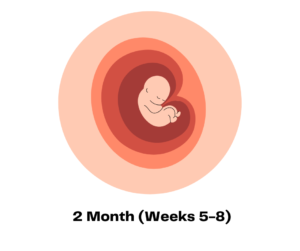 B. Weeks 5-8
B. Weeks 5-8
-During the 5th to 8th week of pregnancy, remarkable changes occur as the fetus continues its rapid development within the womb. Let’s explore these weeks in simple terms:
Week 5: At this stage, the tiny fetus is about the size of a sesame seed. It starts to develop essential organs such as the brain, spinal cord, and heart. The foundation for future body systems, including the circulatory and nervous systems, begins to form.
Week 6: The facial features begin to take shape as the eyes, nose, and mouth start to develop. The fetus also forms limb buds, which will eventually grow into arms and legs. The heart begins to beat, pumping blood through the tiny body.
Week 7: By now, the major organs, like the kidneys and liver, start to form. The face becomes more defined, with the eyes becoming larger and the nose becoming more prominent. The limb buds elongate, and paddle-like hands and feet start to appear.
Week 8: At this stage, the fetus is around the size of a raspberry. Fingers and toes become distinguishable, and tiny nails start to develop. The external genitals begin to form, although it may still be challenging to determine the baby’s gender through ultrasound. The brain continues to grow rapidly, and the fetus starts making small, involuntary movements.
During these weeks, the fetus undergoes remarkable transformations as it lays the foundation for its future development. It’s important to remember that every pregnancy is unique, and individual development can vary slightly. None the less, these milestones represent an awe-inspiring period of growth, setting the stage for the incredible journey that lies ahead.
 C. Weeks 9-12
C. Weeks 9-12
-During Weeks 9 to 12 of pregnancy, the fetus undergoes significant growth and development. Here’s an easy explanation of what happens during this period:
Week 9: At this point, the fetus is about the size of a grape. Its facial features become more defined, with eyes that are growing larger and external ears that are becoming more noticeable. The tiny arms and legs are starting to move more actively, even though the mother may not feel it yet.
Week 10: Now the fetus is about the size of a strawberry. All of its major organs, like the heart, kidneys, and liver, are fully formed and beginning to function. The fingers and toes become more distinct, and the webbing between them starts to disappear. The fetus can move its limbs more freely, though the movements may still go unnoticed by the mother.
Week 11: At this stage, the fetus is about the size of a lime. The head becomes more proportional to the body, and the facial features become even more refined. The external genitals continue to develop, but it may still be difficult to determine the baby’s gender using an ultrasound. The fetus’s movements become more coordinated, and it can flex its limbs.
Week 12: By now, the fetus has grown to the size of a plum. All of its major organs are present and functioning properly. The digestive system starts working, preparing for future feeding. The tiny hands can open and close, and the fingers have distinct fingerprints. The facial profile becomes clearer, and the external ears continue to develop. The fetus can move its limbs even more, although the movements may still be too subtle for the mother to feel.
During these weeks, the fetus goes through significant growth and development, transforming from a tiny cluster of cells into a recognizable human form. It’s important to remember that every pregnancy is unique, and individual development may vary. None the less, these milestones represent an exciting period of progress as the fetus continues to grow and mature.
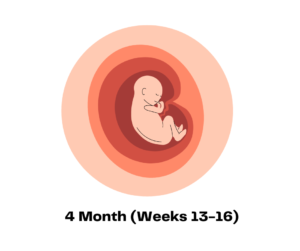 III. Second Trimester: Rapid Growth and Refinement
III. Second Trimester: Rapid Growth and Refinement
A. Weeks 13-16
-During Weeks 13 to 16 of pregnancy, the fetus continues to grow and develop at a rapid pace. Here’s an easy explanation of what happens during this period:
Week 13: At this stage, the fetus has reached the size of a peach. It continues to grow rapidly, and its body becomes more proportionate. The tiny bones are starting to harden, and the intestines are moving from the umbilical cord into the abdomen. The fetus can make sucking motions with its mouth, although it’s still too early for the mother to feel these movements.
Week 14: By now, the fetus is about the size of a lemon. Its facial features become more refined, with the eyebrows and hair starting to grow. The baby’s kidneys start producing urine, which is released into the amniotic fluid surrounding it. The fetus’s movements become more coordinated, but they may still go unnoticed by the mother.
Week 15: At this stage, the fetus has grown to the size of an apple. Its neck becomes more defined, allowing the head to be held upright. The baby’s skin is still transparent, and blood vessels can be seen through it. The tiny limbs can flex and move, and the fetus can even practice sucking its thumb.
Week 16: Now the fetus is about the size of an avocado. Its body is covered in fine hair called lanugo, which helps to protect the delicate skin. The eyes, which were previously positioned wide apart, are moving closer together. The baby’s ears are also positioned in their correct place on the sides of the head. The fetus’s movements become more pronounced, and the mother may start feeling gentle flutters or “quickening.”
During these weeks, the fetus continues to grow and develop, acquiring more human-like features. It’s important to remember that each pregnancy is unique, and individual development may vary slightly. These milestones, however, represent a period of significant progress as the fetus moves toward further maturity.
 B. Weeks 17-20
B. Weeks 17-20
-During Weeks 17 to 20 of pregnancy, the fetus continues to grow and develop, reaching new milestones along the way. Here’s an easy explanation of what happens during this period:
Week 17: At this stage, the fetus is about the size of a pear. Its skeletal system continues to develop and harden. The baby’s skin becomes less transparent as fat deposits start to form underneath, giving a more rounded appearance. The fetus’s movements become stronger and more coordinated, and the mother may start feeling distinct kicks and flutters.
Week 18: Now the fetus is about the size of a bell pepper. Its senses are developing, and the baby can hear sounds from the outside world, including the mother’s voice and heartbeat. The baby’s fingerprints are forming, making each individual unique. Vernix, a waxy substance, covers the baby’s skin to protect it in the amniotic fluid.
Week 19: At this stage, the fetus has grown to the size of a mango. Its hair continues to grow on the scalp, and the eyebrows and eyelashes become more noticeable. The baby’s body is becoming more proportionate as it continues to put on weight. The mother may feel more pronounced movements as the fetus becomes stronger.
Week 20: Now the fetus is about the length of a banana. Its movements are more frequent and stronger, and the mother can feel them more clearly. The baby’s digestive system is developing, and it can swallow amniotic fluid. Lanugo, the fine hair covering the body, becomes thicker to provide insulation. The fetus’s skin is also covered in a waxy coating called vernix caseosa to protect it.
During these weeks, the fetus undergoes significant growth and refinement. It becomes more active and responsive to the outside world. Remember that every pregnancy is unique, and individual development may vary slightly. These milestones represent an exciting period as the fetus continues to thrive and prepare for the next stages of development.
 C. Weeks 21-24
C. Weeks 21-24
-During Weeks 21 to 24 of pregnancy, the fetus experiences significant growth and development, entering a crucial stage of maturation. Here’s an easy explanation of what happens during this period:
Week 21: At this stage, the fetus is about the size of a carrot. Its movements become even more pronounced and coordinated. The baby’s eyelids, which were fused shut, begin to open, allowing it to blink. Taste buds start forming on the tongue, preparing for the sense of taste.
Week 22: Now the fetus is about the size of a papaya. Its skin becomes less transparent as it starts producing more pigment. The baby’s lungs continue to develop, and while they are not yet fully functional, they are preparing to breathe air. The fetus can respond to external sounds, such as voices and music.
Week 23: At this stage, the fetus has grown to the size of a grapefruit. Its skin becomes wrinkled due to the growth of blood vessels underneath. The baby’s sense of movement and balance improves, and it may be seen flipping or somersaulting on ultrasound scans. The fetus also starts developing a sleep-wake cycle.
Week 24: Now the fetus is about the length of an ear of corn. Its body becomes more proportionate as it continues to gain weight. The lungs continue to mature, producing surfactant, a substance that helps the air sacs inflate properly. The baby’s senses, such as hearing and touch, become more refined.
During these weeks, the fetus undergoes further growth and development, preparing for the outside world. It becomes more responsive to sounds and begins to establish regular sleep patterns. Remember that each pregnancy is unique, and individual development may vary. These milestones represent an exciting period as the fetus continues to mature and get ready for the next stages of development.
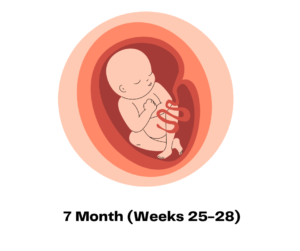 IV. Third Trimester: Preparation for Arrival
IV. Third Trimester: Preparation for Arrival
A. Weeks 25-28
-During Weeks 25 to 28 of pregnancy, the fetus continues to mature and develop, preparing for the final stages of pregnancy. Here’s an easy explanation of what happens during this period:
Week 25: At this stage, the fetus is about the size of a cauliflower. Its body continues to fill out as it gains more weight. The baby’s skin becomes smoother as fat deposits increase. The lungs are developing further, and while they are not fully mature, the baby can practice breathing movements.
Week 26: Now the fetus is about the length of a scallion. Its eyelids, which were previously fused, can now open and close. The baby’s eyes are developing more sensitivity to light, even though vision is still developing. The lungs continue to mature as air sacs, called alveoli, start to form.
Week 27: At this stage, the fetus has grown to the size of a cucumber. Its brain is developing rapidly, and the baby’s senses, such as hearing and touch, are becoming more refined. The lungs are producing more surfactant, which helps them expand and contract properly. The fetus’s movements are more coordinated and vigorous.
Week 28: Now the fetus is about the size of an eggplant. Its eyes, previously positioned wide apart, are moving closer together. The baby’s eyelashes are more defined, and eyebrows are becoming thicker. The lungs continue to mature, and while the baby would still need medical support if born prematurely, there is a greater chance of survival.
During these weeks, the fetus undergoes further development and maturation. It continues to gain weight and refine its senses. The lungs are preparing for breathing, and the baby’s movements become more active and coordinated. Remember that every pregnancy is unique, and individual development may vary. These milestones represent an exciting period as the fetus approaches further growth and readiness for the outside world.
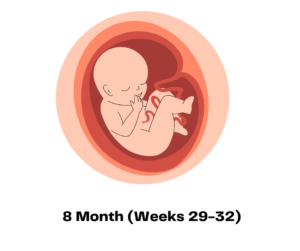 B. Weeks 29-32
B. Weeks 29-32
-During Weeks 29 to 32 of pregnancy, the fetus continues to thrive and prepare for the upcoming birth. Here’s an easy explanation of what happens during this period:
Week 29: At this stage, the fetus is about the size of a butternut squash. It continues to gain weight and fill out, and its skin becomes less wrinkled as fat deposits increase. The baby’s brain is rapidly developing, allowing for more complex thoughts and actions. The fetus’s movements may become more forceful, and the mother can feel distinct kicks and rolls.
Week 30: Now the fetus is about the size of a large cabbage. Its body continues to mature, and its organs are functioning, although some systems still need further development. The baby’s bones are hardening, but they are still flexible to ease the passage through the birth canal. The baby’s eyes can open and close, and it can even track light sources.
Week 31: At this stage, the fetus has grown to the size of a coconut. Its body is becoming rounder and plumper as it accumulates more fat. The baby’s skin becomes smoother, and its nails continue to grow. The bones in the skull remain flexible to allow for easier passage during birth. The baby’s movements may be more limited due to the growing size in the uterus.
Week 32: Now the fetus is about the size of a jicama. Its body continues to mature, with increasing fat deposits to regulate body temperature. The baby’s lungs are nearly fully developed, although they still need additional maturation. The fetus’s movements may feel more like rolls and stretches rather than sharp kicks due to the limited space inside the womb.
During these weeks, the fetus undergoes continued growth and refinement in preparation for birth. It gains more weight, and its body becomes more rounded. Remember that each pregnancy is unique, and individual development may vary slightly. These milestones represent an important period as the fetus nears the final stages of development and gets ready for the next chapter outside the womb.
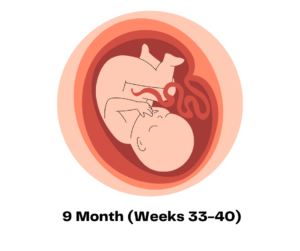 C. Weeks 33-40
C. Weeks 33-40
-During Weeks 33 to 40 of pregnancy, the fetus undergoes remarkable growth and development as it approaches the final stages before birth. Here’s an easy explanation of what happens during this period:
Weeks 33, the fetus is about the size of a pineapple. It continues to grow bigger and stronger. Most of its organs are almost fully developed, and its bones are hardening. The baby practices breathing movements, even though it still receives oxygen through the umbilical cord.
Weeks 34, the fetus reaches the size of a cantaloupe. It continues to gain weight and build up fat stores for warmth after birth. The baby’s body becomes rounder as it fills out in preparation for life outside the womb. The baby’s movements may be more restricted due to limited space in the uterus.
Weeks 35, the fetus is about the size of a honeydew melon. Its growth rate slows down slightly as it focuses on gaining more weight. The baby’s brain development continues, with billions of neurons forming connections. The baby’s kicks and movements may be more forceful and noticeable.
Weeks 36, the fetus is approximately the size of a papaya. It continues to gain weight and develop layers of fat, providing insulation and nourishment. The baby’s skin becomes less wrinkled as it fills out. The baby’s head settles into a downward position, getting ready for the birth process.
Weeks 37, the fetus is about the size of a large bunch of grapes. It is considered “full term” and ready to be born. The baby’s lungs are nearly fully matured, and it can now breathe on its own once outside the womb. The baby’s movements may decrease slightly due to the cramped space in the uterus.
Weeks 38 to 40, the fetus is approximately the size of a watermelon. It continues to gain weight and grow, filling out its cozy space in the womb. The baby’s head may engage in the pelvis, positioning itself for a smoother delivery. The baby’s nails may extend beyond the fingertips, and it is fully prepared for life outside the womb.
During these last weeks of pregnancy, the fetus is getting ready to meet the outside world. It’s an exciting and precious time as the baby’s development nears completion, and the anticipation of holding the little one grows. The countdown to the miraculous journey of childbirth is underway.
In the conclusion, summarize the awe-inspiring journey of fetal development week by week. Highlight the miracles and wonders of human life creation that were witnessed throughout the blog post. Encourage readers to appreciate the incredible journey of fetal development and marvel at the complexities of life unfolding in the womb.